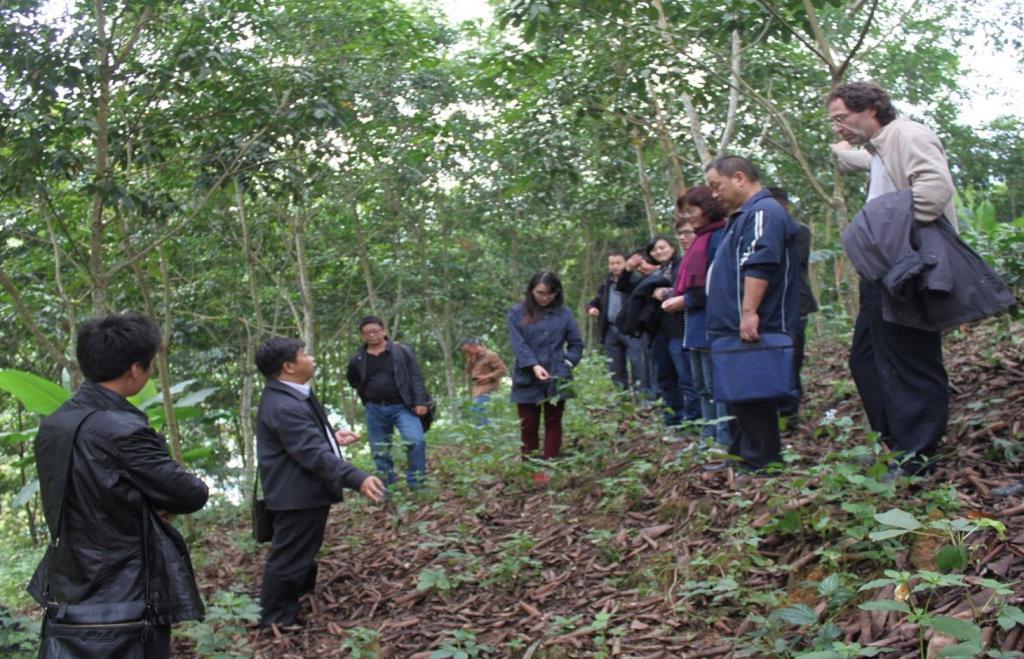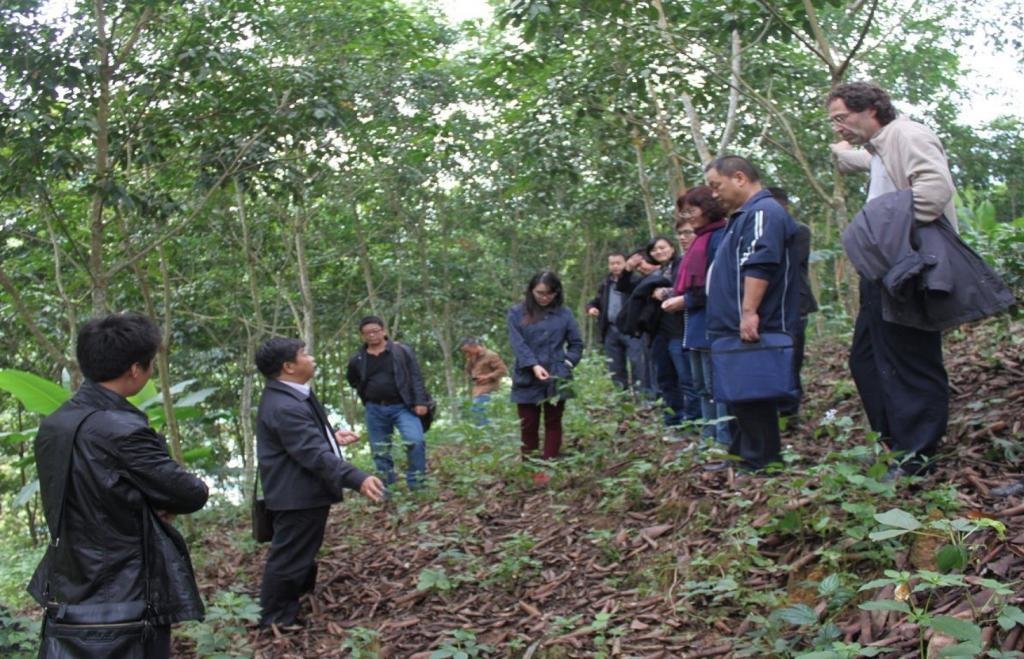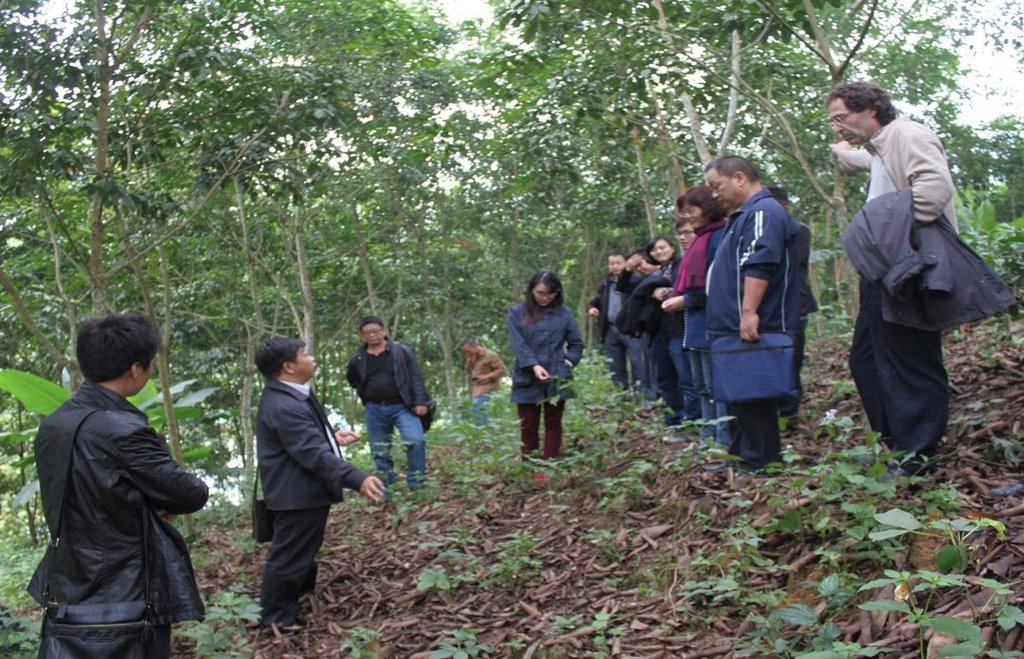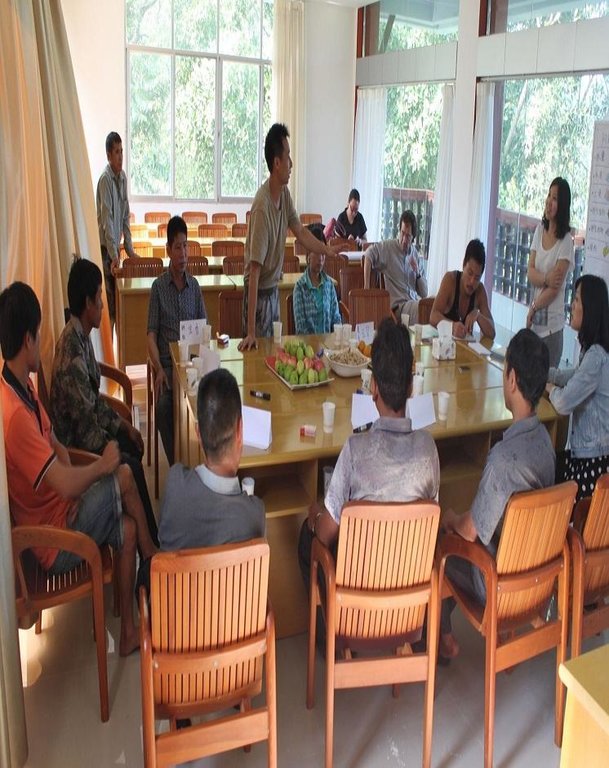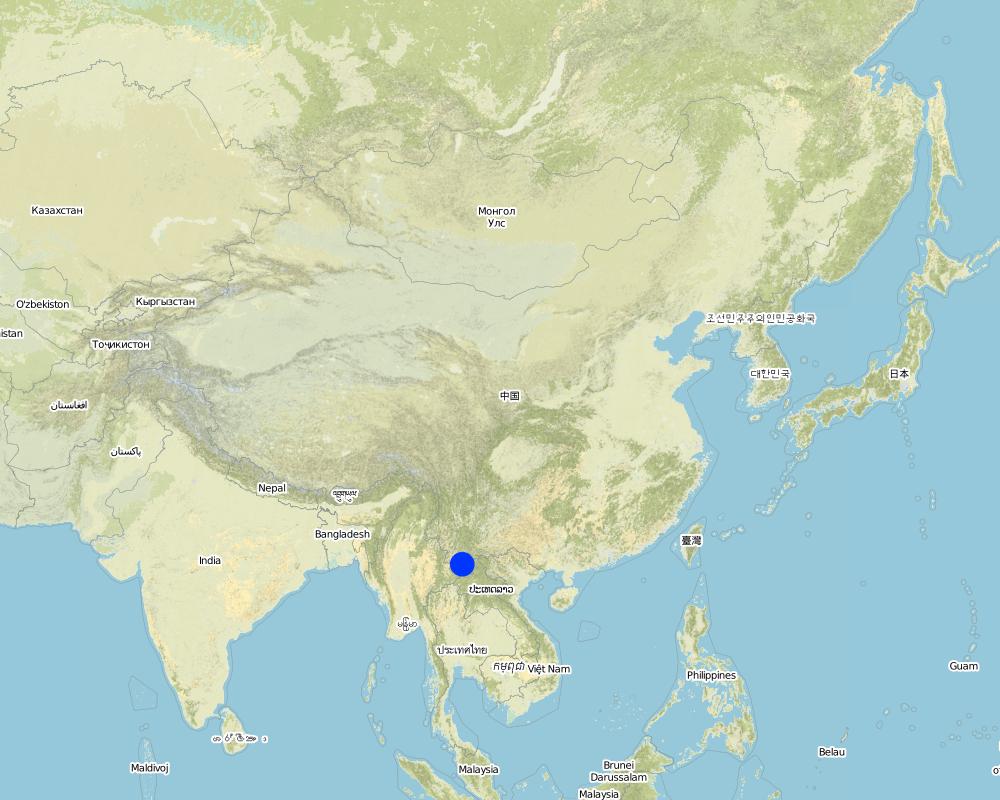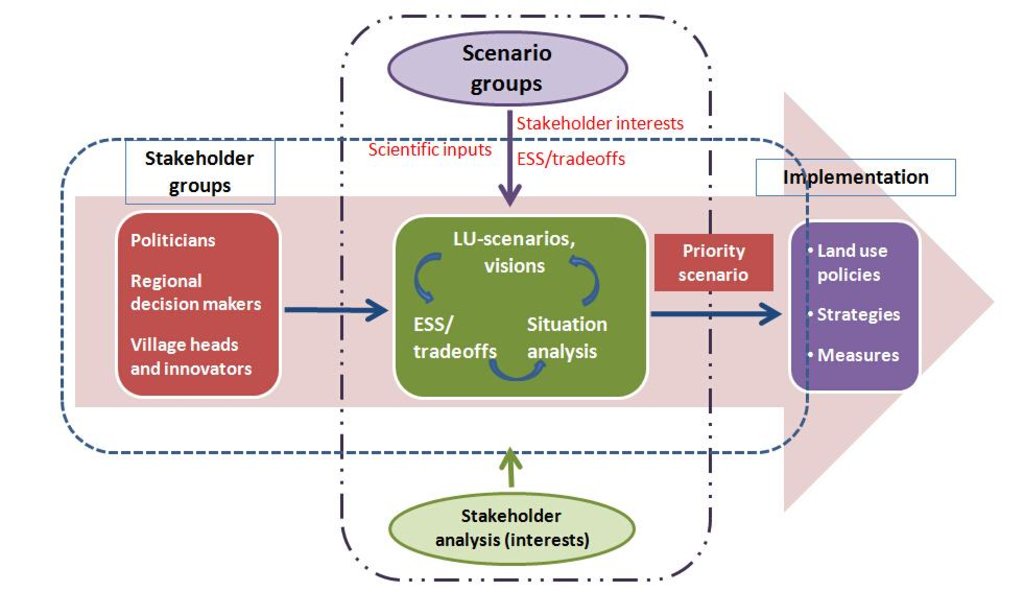Scientist-practitioner communication for sustainable rubber cultivation in China [China]
- Creación:
- Actualización:
- Compilador: Thomas Aenis
- Editor: –
- Revisores: David Streiff, Deborah Niggli
approaches_2618 - China
Visualizar secciones
Expandir todo Colapsar todos1. Información general
1.2 Detalles de contacto de las personas de referencia e instituciones involucradas en la evaluación y la documentación del Enfoque
Nombre del proyecto que facilitó la documentación/ evaluación del Enfoque (si fuera relevante)
Book project: Making sense of research for sustainable land management (GLUES)Nombre de la(s) institución(es) que facilitaron la documentación/ evaluación del Enfoque si fuera relevante)
Universität Hohenheim - AlemaniaNombre de la(s) institución(es) que facilitaron la documentación/ evaluación del Enfoque si fuera relevante)
Humboldt Universität zu Berlin (HU Berlin) - AlemaniaNombre de la(s) institución(es) que facilitaron la documentación/ evaluación del Enfoque si fuera relevante)
China Agricultural University (China Agricultural University) - China1.3 Condiciones referidas al uso de datos documentados mediante WOCAT
¿Cuándo se compilaron los datos (en el campo)?
27/01/2016
El compilador y la/s persona(s) de referencia claves aceptan las condiciones acerca del uso de los datos documentados mediante WOCAT :
Sí
2. Descripción del Enfoque MST
2.1 Breve descripción del Enfoque
Establishing communication between scientists and practitioners to improve sustainable rubber cultivation in Yunnan, China
2.2 Descripción detallada del Enfoque MST
Descripción detallada del Enfoque MST:
Aims / objectives: The Sino-German project “SURUMER: Sustainable rubber cultivation in the Mekong Region” is identifying appropriate, stakeholder-validated concepts for sustainable rubber cultivation in Xishuangbanna prefecture, South-west China. In order to at least begin to implement solutions for problems arising from monoculture, project partners from five German and seven Chinese research institutes and practitioner partners are testing a holistic approach. This combines communication activities (bilateral, as well as groups, mainly through workshops) with scientific analysis to enhance interaction and collaborative learning between practitioners and researchers.
Methods: The approach comprises a pragmatic combination of discourse instruments such as direct communication amongst partners, bilingual information material, newsletters, focus groups, and a series of workshops with key stakeholders. One of its main elements is participatory scenario development - including discussions on problem situations, priorities regarding ecosystem services, and trade-offs in different land use strategies.
Stages of implementation: During the first three-year phase of research, ecosystem functions and services were assessed and quantified. This phase of situation analysis had a clear multidisciplinary focus amongst researchers (topics as widely varied as carbon sequestration, pollination, and household economy). The next phase attempted to integrate findings from on-site measurements, household surveys, policy analyses and joint problem solving into identifying new land management options. A modelling approach which uses assessment indicators to define impacts of land management was chosen. The model also identifies trade-offs and synergies in different land management options. During this phase, demonstration trials were established at the plot level. In the last phase, the focus has shifted more and more towards implementation activities, for example policy briefings and training for farmers, village heads and administrative staff. Discussions with key actors amongst the practitioners, who can influence implementation, have started as early as possible. This follows the assumption that the more “realistic” the concepts are, and the better they are communicated to, and discussed with, the stakeholders, the greater the likelihood of implementation.
Role of stakeholders: Apart from the scientists, three key stakeholder groups have been identified, namely rubber farmers (often the village heads), regional decision-makers (prefecture administration and rubber companies), and provincial politicians. The main initiative, as well as the process of moderation, came from the group of scientists. Practitioners participate regularly at workshops and meetings. They express their interests regarding future rubber cultivation, and the information they would like to get from the researchers, and how this should be communicated.
Other important information: Experience shows that communication processes initiated by research play a key role and must be managed carefully. It is clear that significant resources and long-term commitment are needed, and that even “long” research projects of five years are not sufficient to reach full implementation or create impact.
2.3 Fotos del Enfoque
2.5 País/ región/ lugares donde el Enfoque fue aplicado
País:
China
Región/ Estado/ Provincia:
Yunnan
Especifique más el lugar :
Xishuangbanna
Map
×2.6 Fechas de inicio y conclusión del Enfoque
Indique año del inicio:
2012
Año de conclusión (si el Enfoque ya no se aplica):
2016
2.7 Tipo de Enfoque
- proyecto/ basado en un programa
2.8 Propósitos/ objetivos principales del Enfoque
The Approach focused mainly on SLM with other activities (Joint situation analysis, land use objectives/scenarios, networking (scientists & practitioners))
The holistic approach towards research-practice-integration combines scientific analyses with a range of activities to enhance interaction and collaborative learning amongst practitioners and researchers. This fosters the development of sustainable land use practices – amongst others the related technology: “Mitigating negative impacts of rubber monocultures by integrating native trees and changed weed management – and policies” (with an emphasis on sustainable rubber cultivation), and a start to implementation of project research results.
The SLM Approach addressed the following problems: In Xishuangbanna, Southwest China, monocultivation of rubber (Hevea brasiliensis) has enhanced farmers’ livelihoods fundamentally - but also caused severe environmental and societal problems. In order to sustain land use, a high standard of interdisciplinary integration as well as transdisciplinary communication and cooperation between researchers, practitioners and policy/administration is required this is to (at least partially) implement solutions to the complex problems related to sustainable land management. The more heterogeneous the actors are, the more challenging is the process of effective communication. However, commonly, neither procedures nor channels are established for such communication.
2.9 Condiciones que facilitan o impiden la implementación de la/s Tecnología/s aplicadas bajo el Enfoque
normas y valores sociales/ culturales/ religiosos
- impiden
Local stakeholders are not well aware of the linkage between rubber monoculture and environmental degradation, and that the high profitability of rubber encourages this monoculture.
Treatment through the SLM Approach: Through a small exhibition, focus group discussions, workshops and meetings, the research results and scientific findings have been presented to local stakeholders in order to raise awareness.
entorno institucional
- impiden
Under the framework conditions of rural China with its strong social hierarchy, decision-making is top-down. Farmers are very dependent on the government. Participation in regional land use planning is not an established concept, and local people are hesitant to actively demand change. They seldom try out innovations such as intercropping or reduced use of agro-chemicals by themselves: rather they accept government-led innovations - if they are subsidised.
Treatment through the SLM Approach: Changing farmers’ perceptions of technologies through ongoing communication: bilateral communication, focus group discussions and workshops. Awareness building about the problem and general approach: Training on “responsible use of agro-chemicals”. Demonstration plots could serve for monitoring of effects and as the location for future field schools.
marco de trabajo legal (tenencia de tierra, derechos de uso de tierra y agua)
- impiden
Farmers might not want to invest in trees because of limited duration of the land rights (maximum 50 to 70 years of usufruct right only), and rented land (usually 10-year contracts).
Treatment through the SLM Approach: No (ongoing discussion external to the project).
The existing land ownership, land use rights / water rights moderately hindered the approach implementation Water management and land use management always involves different stakeholders along the river or in the area, with complex ownership or user rights. Under the framework condition in rural China, it is difficult to involve different stakeholders and set-up a stakeholder dialogue, especially with those who have conflicting interests.
carga de trabajo, disponibilidad de mano de obra
- impiden
Practitioners in the SURUMER research project are not convinced by the importance and necessity of stakeholder dialogue.
Treatment through the SLM Approach: Internal communication during plenary workshops, etc., to achieve agreement on stakeholder involvement and the role and responsibility of scientist in the stakeholder dialogue.
3. Participación y roles de las partes interesadas involucradas
3.1 Partes interesadas involucradas en el Enfoque y sus roles
- usuarios locales de tierras/ comunidades locales
Village heads as representatives, farmers
Poor farmers involved during baseline survey, using semi-structured interviews.
- especialistas MST/consejeros agrícolas
Experts from Xishuangbanna Tropical Botanic Garden and Yunnan Institute of Tropical Crops
- gobierno local
Regional administrative, research institutes, company
- gobierno nacional (planificadores, autoridades)
Prefecture
Regional administratives such as people from Xishuangbanna Agricultural Bureau, Bio-industry Development office, Xishuangbanna Environmental Protection Bureau, Xishuangbanna Reclamation Bureau, Xishuangbanna Forest Bureau, and Naban River Watershed National Nature Reserve Bureau
- organización internacional
SURUMER project
3.2 Involucramiento de los usuarios locales de tierras/ comunidades locales en las distintas fases del Enfoque
| Involucramiento de los usuarios locales de tierras/ comunidades locales | Especifique quién se involucró y describa las actividades | |
|---|---|---|
| iniciación/ motivación | ninguno | |
| planificación | pasivo | Approach and Technology planned by German and Chinese scientists with local partners: most important the Naban River Watershed National Nature Reserve Bureau. Mainly by informal communication, meetings and planning workshops. |
| implementación | interactivo | German and Chinese researchers cooperated in organizing stakeholder workshops and presenting preliminary research results . Three groups of stakeholders (politicians, regional decision makers, and village heads) were actively involved through interviews, focus groups, etc. Nature reserve administration operates demonstration plots, supervised by German scientists, who are also responsible for performance monitoring. |
| monitoreo y evaluación | pasivo | Stakeholders who participated in the dialogue are asked to give feedback and to evaluate the approach. The approach was also evaluated by an external team of experts. |
| Research | pasivo | Land users were the main source of information for stakeholder analysis, economic studies, and a study on willingness to accept changes. Results of research were fed back into the approach. For example by presenting the concept and preliminary results of the technique (e.g. integrating native trees) in the framework of stakeholder workshops in which further management options (e.g. reduced use of agro-chemicals) were discussed. |
3.3 Flujograma (si estuviera disponible)
Descripción:
The discourses with the three stakeholder groups are focused on a joint situation analysis, discussion on the future of rubber, and discussion about ecosystem services and functions under different scenarios. Land use options are developed jointly and consequences concerning local policies, cultivation measures and market strategies are then discussed. Stakeholder discourses are linked with integrated scenario assessment and modelling by an interdisciplinary group of scientists.
Autor:
Aenis, Thomas
3.4 La toma de decisiones en la selección de Tecnología(s) MST
Especifique quién decidió la selección de las Tecnología/ Tecnologías a implementarse:
- principalmente por especialistas MST en consulta con usuarios de tierras
Explique:
Considering the problems and interests of land users, specialists developed certain technologies. These were discussed and approved by land users.
Decisions on the method of implementing the SLM Technology were made by mainly by SLM specialists with consultation of land users. The original idea was developped by the researchers and valuated by local partners. After implementation, feedback from the participants led to an improvement of the approach. For an example, practitioners demanded preliminary results which then was discussed in the frame of the workshops.
4. Apoyo técnico, fortalecimiento institucional y gestión del conocimiento
4.1 Construcción de capacidades / capacitación
¿Se proporcionó la capacitación a usuarios de tierras/ otras partes interesadas?
Sí
Especifique quién fue capacitado:
- usuarios de tierras
- personal de campo/ consejeros
Forma de capacitación:
- de agricultor a agricultor
- áreas de demostración
- reuniones públicas
- cursos
Temas avanzados:
Training focused (a) on agro-chemicals: problems, awareness, treatment; (b) on water protection: awareness, treatment; (c) on intercropping: demonstration
4.2 Servicio de asesoría
¿Los usuarios de tierras tienen acceso a un servicio de asesoría?
Sí
Especifique si servicio proporcionado se realizó:
- en los campos de los usuarios de tierras
Describa/ comentarios:
the nature reserve administration organized the training and operates the demonstration field.
4.3 Fortalecimiento institucional (desarrollo institucional)
¿Se establecieron o fortalecieron instituciones mediante el Enfoque?
- no
4.4 Monitoreo y evaluación
¿El monitoreo y la evaluación forman parte del Enfoque?
Sí
Comentarios:
no. of land users involved aspects were regular monitored by project staff through observations; indicators: None
management of Approach aspects were regular monitored by project staff through observations; indicators: None
There were few changes in the Approach as a result of monitoring and evaluation: Regional stakeholder workshops were planned twice per year. However, through the stakeholder evaluation process it was learned that once a year would be better. So the approach was adjusted. There was also a shift from open discussion towards a more structured format of result presentation and discussion of management options.
4.5 Investigación
¿La investigación formó parte del Enfoque?
Sí
Especifique los temas:
- sociología
- economía/ marketing
Proporcione detalles adicionales e indique quién hizo la investigación:
1. Research on transdiciplinary communication and stakeholder participation.
2. Research on rubber value chain and alternatives
Research was carried out both on station and on-farm
5. Financiamiento y apoyo material externo
5.1 Presupuesto anual para el componente MST del Enfoque
Si no se conoce el presupuesto anual preciso, indique el rango:
- 10,000-100,000
Comentarios (ej. fuentes principales de financiamiento/ donantes principales):
Approach costs were met by the following donors: international (concept and implementation, facilitation; etc (Federal Ministry of Education and Research, BMBF) ): 90.0%; local government (district, county, municipality, village etc) ( prefecture): 10.0%
5.2 Apoyo financiero/material proporcionado a los usuarios de tierras
¿Los usuarios de tierras recibieron financiamiento/ apoyo material para implementar la Tecnología/ Tecnologías? :
No
5.4 Crédito
¿Se proporcionó crédito bajo el Enfoque para actividades MST?
No
6. Análisis de impacto y comentarios de conclusión
6.1 Impactos del Enfoque
¿El Enfoque ayudó a los usuarios de tierras a implementar y mantener Tecnologías MST?
- No
- Sí, un poco
- Sí, moderadamente
- Sí, mucho
1. Through research-practice interaction, the land users get to know that there are linkages between large-scale rubber monoculture and environmental degradation. 2. The stakeholders get to know each other, expand their communication networks, which will help when they are making land-use and land management decisions. 3. The stakeholders get access to latest scientific results on sustainable land management from the SURUMER project, which provides them new options for sustainable land management.
¿El Enfoque empoderó a grupos en desventaja social y económica?
- No
- Sí, un poco
- Sí, moderadamente
- Sí, mucho
The effect can only be seen in the long term.
¿El Enfoque mejoró cuestiones de tenencia de tierra/ derechos de usuarios que obstaculizaron la implementación de la Tecnologías MST?
- No
- Sí, un poco
- Sí, moderadamente
- Sí, mucho
Stakeholder dialogue approach could improve the communication and deliver the research results, however the land users are the one to decide to take the conservation activities or not. The approach have low effect on land users behavior. The problem is unlikely to be overcome in the near future. The institutional issues could not be overcome only by efforts from research projects.
Did other land users / projects adopt the Approach?
- No
- Sí, un poco
- Sí, moderadamente
- Sí, mucho
The Green Rubber project which is led by the local research institute, has included stakeholder dialogue as an element.
Did the Approach lead to improved livelihoods / human well-being?
- No
- Sí, un poco
- Sí, moderadamente
- Sí, mucho
Not yet. The effects of improved livelihoods can only be seen in the long term.
Did the Approach help to alleviate poverty?
- No
- Sí, un poco
- Sí, moderadamente
- Sí, mucho
Once again, the effect will only be seen in the long term.
6.2 Motivación principal del usuario de la tierra para implementar MST
- reglas y reglamentos (multas)/ aplicación
There are regional regulations towards more 'green' rubber cultivation
- conciencia medioambiental
To protect the water quality and quantity, and biodiversity
- well-being and livelihoods improvement
6.3 Sostenibilidad de las actividades del Enfoque
¿Pueden los usuarios de tierras sostener lo que se implementó mediante el Enfoque (sin apoyo externo)?
- incierto
Si respondió no o incierto, especifique y comente:
In the SURUMER project, the stakeholder dialogue is designed and facilitated by project staff. Although our local partner and local stakeholders give very positive feedback regarding this process, it is hard to say that they will continue such an approach without external support.
6.4 Fortalezas/ ventajas del Enfoque
| Fuerzas/ ventajas/ oportunidades desde la perspectiva del usuario de la tierra |
|---|
| Through wide participation, it is more likely that decisions are fair. (How to sustain/ enhance this strength: Take all possible stakeholders into consideration; attention needs to be paid to those groups with power, and those without.) |
| Various participation methods together enrich the information and provide the possibility of cross-checking. (How to sustain/ enhance this strength: Documentation of how the methods have been applied under which situation, for further application.) |
| Social learning with changing attitudes and behaviour towards participation in the long term. (How to sustain/ enhance this strength: Continued communication and exchange.) |
| Fuerzas/ ventajas/ oportunidades desde la perspectiva del compilador o de otra persona de referencia clave |
|---|
|
Stakeholders are widely targeted from the decision makers to the end users e.g. farmers. (How to sustain/ enhance this strength: Transfer the network from the project to the stakeholders themselves, build interlinks among stakeholders.) |
| Efficient communication via various channels, which together produce holistic and valuable knowledge about problems and possible solutions. (How to sustain/ enhance this strength: Choose suitable communication channels according to the specific situation and stakeholder group.) |
| A workshop series is a suitable structure for in-depth discussion with key regional decision-makers on focus topics. (How to sustain/ enhance this strength: The local partner is interested in the way that such participation processes take place, and has expressed willingness to transfer such an approach into collaboration with other partners.) |
6.5 Debilidades/ desventajas del Enfoque y formas de sobreponerse a ellos
| Debilidades/ desventajas/ riesgos desde la perspectiva del usuario de la tierra | ¿Cómo sobreponerse a ellas? |
|---|---|
| Because of social hierarchy, and the top-down decision-making system, participation is not a well-established concept, and local people are hesitant to take part in it. | Information flow increased from researchers to stakeholders, understanding and trust built through showing research results with the issues they are most concerned with, such as water quality and quantity, soil degradation, value chains and market studies. They are interested in the topic and gradually began to actively participate. |
| It is not possible to discuss the scientific scenarios with local stakeholders due to the insurmountable gulf between modellers’ academic jargon and everyday language. | Adjustment of scenario discussion, discuss further expectations with stakeholders instead, which could be translated into trade-offs and integrated into modelling. |
| Debilidades/ desventajas/ riesgos desde la perspectiva del compilador o de otra persona de referencia clave | ¿Cómo sobreponerse a ellas? |
|---|---|
| Cost in terms of various resources: labour, time, money. | Choose the most suitable way of participation based on efficiency. |
| Process is slower than expected. | Clear consensus has to be reached beforehand. |
| Scientists’ interests are much more in research than in interactive activities. | Internal discussion is needed, it deepens understanding about the whole project. |
7. Referencias y vínculos
7.1 Métodos/ fuentes de información
- visitas de campo, encuestas de campo
- entrevistas con usuarios de tierras
7.2 Referencias a publicaciones disponibles
Título, autor, año, ISBN:
Aenis, Thomas and Wang Jue (2016): From information giving to mutual scenario definition: Stakeholder participation towards Sustainable Rubber Cultivation in Xishuangbanna, Southwest China.
¿Dónde se halla disponible? ¿Costo?
Aenis, Thomas, Andrea Knierim, Maja-Catrin Riecher, Rebecka Ridder, Heike Schobert, Holger Fischer (eds.) (2016a): Farming Systems Facing Global Challenges: Capacities and Strategies. Volume 1 – Proceeding. Online: urn:nbn:de:kobv:11-100236919
Título, autor, año, ISBN:
Wang Jue, Thomas Aenis and Susanne Hofmann-Souki (2016): Triangulation in participation: Approaches for science-practice interaction in land-use decision making in rural China
¿Dónde se halla disponible? ¿Costo?
Submitted to Land Use Policy
Título, autor, año, ISBN:
Aenis, Thomas, Susanne Hofmann-Souki, Uwe Jens Nagel, Tang Lixia & Wang Jue (Eds.) with contributions by Sandra I. Cruz Moreno, Joseph Cutler, Mark Larson, Georg Liebig, James Longanecker, Cornelia Kinkel, Laura Kübke, Friederike Martin, Kirstin Ohlendorf, Rebecka Ridder, Karina Rodriguez Jardines, and Sim Lay Mei (2014): Rubber cultivation and livelihood - a stakeholder analysis in Xishuangbanna
¿Dónde se halla disponible? ¿Costo?
Humboldt-Universität zu Berlin. Online: urn:nbn:de:kobv:11-100216241
7.3 Vínculos a la información relevante disponible en línea
Título/ descripción:
Hofmann-Souki, Susanne, Napoleón Molina, Wolfgang Bokelmann and Robert Cárcamo Mallen (2016): Participatory assessment of value chains for diversifying small-scale farms – developing a tool for practitioner-led analysis and innovation
URL:
http://www.harper-adams.ac.uk/events/ifsa-conference/papers/5/5.5%20Hoffman.pdf
Vínculos y módulos
Expandir todo Colapsar todosVínculos
No hay vínculos
Módulos
No se hallaron módulos


